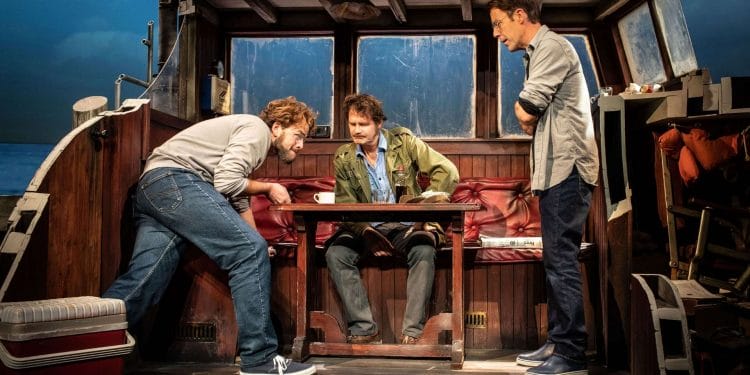 When The Shark Is Broken premiered at the Edinburgh Fringe in 2019, more than one reviewer commented that this was a play that would make waves. Indeed, it went on to have a hugely successful run that had audiences queuing for returns daily. Given the welcome trend of Edinburgh shows transferring to the West End, it was little surprise when it was announced that The Shark Is Broken would come to the Ambassador’s Theatre.
When The Shark Is Broken premiered at the Edinburgh Fringe in 2019, more than one reviewer commented that this was a play that would make waves. Indeed, it went on to have a hugely successful run that had audiences queuing for returns daily. Given the welcome trend of Edinburgh shows transferring to the West End, it was little surprise when it was announced that The Shark Is Broken would come to the Ambassador’s Theatre.
Of course, pandemic delays means that this witty three-hander opens more than a year late, but audiences will probably agree that it has been worth the wait.
Co-Written by Ian Shaw, the real-life son of Robert Shaw, along with Joseph Nixon. The Shark Is Broken is based on the diaries of Shaw Sr., covering the infamous behind-the-scenes difficulties that occurred during the location shoot of Jaws.
The writer plays his own father, and the family resemblance makes for a beguiling watch. He is joined in the cramped cabin of The Orca by Roy Scheider (Demetri Goritsas) and Richard Dreyfuss (Liam Murray Scott).
As the title suggests, the mechanical sharks featured in Jaws (no CGI in those days) were frequently out of action, causing massive delays to filming, and leaving Scheider, Shaw and Dreyfuss with endless hours, and days, to fill.
Much of the comedy comes from the antagonism between the characters. Dreyfuss is an easy target for Shaw to take a bite out of, seeing the fledgling actor as fame hungry and shallow. At one point Shaw suggests to Dreyfuss, who has expressed an interest in taking to the London stage, that Harold Pinter would simply love to hear Dreyfuss’s theories on the meaning of some of his plays.
Scheider has the knack of irritating the others by being a bit of a bore, but in reality he’s the glue that keeps the trio together, and probably succeeds in preventing more than one full scale fist fight breaking out.
The discontent and one-up-man-ship provides the audience with plenty to enjoy, but The Shark Is Broken is at its most revealing when the camaraderie of the three comes into play. Shaw’s drinking causes concern and their attempts to support him shows the affection that can develop when people are trapped in difficult circumstances.
This switching from funny to endearing, and back again, works in large part thanks to the faultless performances of the three actors on stage. Shaw’s gritty performance as his own father is a real delight to watch, while Liam Murray Scott’s youthful exuberance and vulnerability captures the audience’s attention. Goritsas makes it all look effortless bringing calmness and harmony to proceedings.
Bruce, the actors nickname for the shark, never actually makes an appearance for us, instead the action is all centred in the cabin of The Orca. Duncan Henderson’s design highlights the claustrophobic nature of the situation, with the actors rarely moving from a small table, the rest of the stage is transformed into a wide expanse of the Atlantic ocean, off the coast of Martha’s Vineyard, through Nina Dunn’s video design.
Adam Cork’s sound design gives us not only that instantly recognisable theme tune, but also little touches like the creaking of the boat, that adds just another aspect of realism to Guy Masterson’s already authentic direction.
In the West End The Shark Is Broken runs fifteen minutes longer than it did in Edinburgh, and it does make a slight difference to the pacing, which no longer feels as punchy as it once did. However, strong writing and astute performances makes this a superb addition to the West End, and is a fascinating look below the surface of Spielberg’s Hollywood hit.























Comments 4